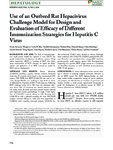Use of an Outbred Rat Hepacivirus Challenge Model for Design and Evaluation of Efficacy of Different Immunization Strategies for Hepatitis C Virus
| dc.contributor.author | Atcheson, E | |
| dc.contributor.author | Li, W | |
| dc.contributor.author | Bliss, CM | |
| dc.contributor.author | Chinnakannan, S | |
| dc.contributor.author | Heim, K | |
| dc.contributor.author | Sharpe, H | |
| dc.contributor.author | Hutchings, C | |
| dc.contributor.author | Dietrich, I | |
| dc.contributor.author | Nguyen, D | |
| dc.contributor.author | Kapoor, A | |
| dc.contributor.author | Jarvis, Michael A | |
| dc.contributor.author | Klenerman, P | |
| dc.contributor.author | Barnes, E | |
| dc.contributor.author | Simmonds, P | |
| dc.date.accessioned | 2020-09-15T12:36:24Z | |
| dc.date.issued | 2020-03 | |
| dc.identifier.issn | 0270-9139 | |
| dc.identifier.issn | 1527-3350 | |
| dc.identifier.uri | http://hdl.handle.net/10026.1/16343 | |
| dc.description.abstract |
<jats:sec> <jats:title>Background and Aims</jats:title> <jats:p>The lack of immunocompetent small animal models for hepatitis C virus (HCV) has greatly hindered the development of effective vaccines. Using rodent hepacivirus (RHV), a homolog of HCV that shares many characteristics of HCV infection, we report the development and application of an RHV outbred rat model for HCV vaccine development.</jats:p> </jats:sec> <jats:sec> <jats:title>Approach and Results</jats:title> <jats:p>Simian adenovirus (ChAdOx1) encoding a genetic immune enhancer (truncated shark class II invariant chain) fused to the nonstructural (NS) proteins NS3‐NS5B from RHV (ChAd‐NS) was used to vaccinate Sprague‐Dawley rats, resulting in high levels of cluster of differentiation 8–positive (CD8<jats:sup>+</jats:sup>) T‐cell responses. Following RHV challenge (using 10 or 100 times the minimum infectious dose), 42% of vaccinated rats cleared infection within 6‐8 weeks, while all mock vaccinated controls became infected with high‐level viremia postchallenge. A single, 7‐fold higher dose of ChAd‐NS increased efficacy to 67%. Boosting with ChAd‐NS or with a plasmid encoding the same NS3‐NS5B antigens increased efficacy to 100% and 83%, respectively. A ChAdOx1 vector encoding structural antigens (ChAd‐S) was also constructed. ChAd‐S alone showed no efficacy. Strikingly, when combined with ChAd‐NS, ChAD‐S produced 83% efficacy. Protection was associated with a strong CD8<jats:sup>+</jats:sup> interferon gamma–positive recall response against NS4. Next‐generation sequencing of a putative RHV escape mutant in a vaccinated rat identified mutations in both identified immunodominant CD8<jats:sup>+</jats:sup> T‐cell epitopes.</jats:p> </jats:sec> <jats:sec> <jats:title>Conclusions</jats:title> <jats:p>A simian adenovirus vector vaccine strategy is effective at inducing complete protective immunity in the rat RHV model. The RHV Sprague‐Dawley rat challenge model enables comparative testing of vaccine platforms and antigens and identification of correlates of protection and thereby provides a small animal experimental framework to guide the development of an effective vaccine for HCV in humans.</jats:p> </jats:sec> | |
| dc.format.extent | 794-807 | |
| dc.format.medium | Print-Electronic | |
| dc.language | en | |
| dc.language.iso | en | |
| dc.publisher | Wiley | |
| dc.subject | Adenoviridae | |
| dc.subject | Animals | |
| dc.subject | CD8-Positive T-Lymphocytes | |
| dc.subject | Disease Models, Animal | |
| dc.subject | Epitopes, T-Lymphocyte | |
| dc.subject | Hepacivirus | |
| dc.subject | Interferon-gamma | |
| dc.subject | Male | |
| dc.subject | Rats | |
| dc.subject | Rats, Sprague-Dawley | |
| dc.subject | Vaccination | |
| dc.subject | Vaccines, Synthetic | |
| dc.subject | Viral Hepatitis Vaccines | |
| dc.subject | Viral Nonstructural Proteins | |
| dc.title | Use of an Outbred Rat Hepacivirus Challenge Model for Design and Evaluation of Efficacy of Different Immunization Strategies for Hepatitis C Virus | |
| dc.type | journal-article | |
| dc.type | Journal Article | |
| dc.type | Research Support, Non-U.S. Gov't | |
| plymouth.author-url | https://www.webofscience.com/api/gateway?GWVersion=2&SrcApp=PARTNER_APP&SrcAuth=LinksAMR&KeyUT=WOS:000489670300001&DestLinkType=FullRecord&DestApp=ALL_WOS&UsrCustomerID=11bb513d99f797142bcfeffcc58ea008 | |
| plymouth.issue | 3 | |
| plymouth.volume | 71 | |
| plymouth.publication-status | Published | |
| plymouth.journal | Hepatology | |
| dc.identifier.doi | 10.1002/hep.30894 | |
| plymouth.organisational-group | /Plymouth | |
| plymouth.organisational-group | /Plymouth/Faculty of Health | |
| plymouth.organisational-group | /Plymouth/Faculty of Health/School of Biomedical Sciences | |
| plymouth.organisational-group | /Plymouth/REF 2021 Researchers by UoA | |
| plymouth.organisational-group | /Plymouth/REF 2021 Researchers by UoA/UoA01 Clinical Medicine | |
| plymouth.organisational-group | /Plymouth/Research Groups | |
| plymouth.organisational-group | /Plymouth/Research Groups/Institute of Translational and Stratified Medicine (ITSMED) | |
| plymouth.organisational-group | /Plymouth/Research Groups/Institute of Translational and Stratified Medicine (ITSMED)/CBR | |
| plymouth.organisational-group | /Plymouth/Users by role | |
| plymouth.organisational-group | /Plymouth/Users by role/Academics | |
| dc.publisher.place | United States | |
| dcterms.dateAccepted | 2019-08-05 | |
| dc.rights.embargodate | 2020-9-19 | |
| dc.identifier.eissn | 1527-3350 | |
| dc.rights.embargoperiod | Not known | |
| rioxxterms.versionofrecord | 10.1002/hep.30894 | |
| rioxxterms.licenseref.uri | http://www.rioxx.net/licenses/all-rights-reserved | |
| rioxxterms.licenseref.startdate | 2020-03 | |
| rioxxterms.type | Journal Article/Review |


